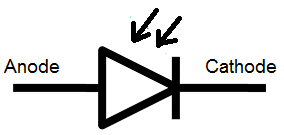A - Explain the symbols, operating principles and usage areas of the diodes given below. (Zener diode: photo diode: led diode: opto coupler) B- Draw the voltage trigger circuit and explain its operation. Explain how there is a difference between the voltage quadrant and the tripler
Analysis of Diode
It is a semiconductor device in electronics applications where only a one-way current is required. It is like a one-way switch that allows current to flow in one direction only. A diode has two terminals, a cathode, and an anode. The cathode is the negative terminal that carries electrons, while the anode is the positive terminal that carries holes. Although no element has holes, it just means that there is a free space for electrons. Diodes are used to convert AC to DC. As we know, AC shifts between positive and negative cycles and DC stays positive constantly. As the diodes allow current only in one direction, they filter out the AC signal’s negative cycle and only keep the positive one.
Working and Construction
In civil engineering, construction means the application of principles of science and mathematics for building bridges, dams, buildings, roads, highways, tunnels, airports, structures, etc. Different branches of science, like physics and chemistry, are extensively applied to design and analysis in construction. Material properties, the science of atmospheric conditions (like solutions, mixtures, etc.), the impact of environmental factors like, corrosion and acidity are some of the primary knowledge of chemistry which are used by civil engineers to carry out construction. Estimation of forces, application of laws of mechanics, fluids mechanics, soil mechanics, etc. are some of the fundamental concepts of physics, which are well applied in construction works. Building construction and structural engineering are two of the most primary areas in civil engineering that parallelly applies principles of both chemistry and physics to carry on construction works.
Property of Diode
An electronic component that facilitates the directional flow of current is known as a diode. According to the direction of the flow of current, the resistance of a diode changes from zero to Infinity.
A - Explain the symbols, operating principles and usage areas of the diodes given below. (Zener diode: photo diode: led diode: opto coupler)
B- Draw the voltage trigger circuit and explain its operation. Explain how there is a difference between the voltage quadrant and the tripler
ZENER diode:-
The ZENER diode is a PN junction diode but this diode operates in the reverse bias mode. This is a special type of PN junction diode which is highly doped. When this diode is highly doped, the concentration of impurity atoms is more in the crystal. This higher concentration of impurity atoms causes a higher concentration of ions in the depletion layer. Therefore, for the applied reverse-biased voltage, the width of the depletion layer becomes smaller than that in a normal diode.
Due to this smaller depletion layer, voltage gradient or electric field strength across the depletion layer is quite large. If the reverse voltage is continued to increase, after a certain applied voltage, the electrons from the covalent bonds within the depletion region come out and make the depletion region conductive. The breakdown occurs is known as the Zener breakdown. The voltage at which this breakdown occurs is called Zener voltage. If the applied reverse voltage across the diode is more than the Zener voltage.

ZENER diode is generally used in the application of voltage regulators, surge suppressors, etc.
Photodiode:-
The photodiode is another type of PN junction diode which consume light energy to produce an electric current. It is also called photo-resistor or photo-sensors.
The working principle involved when a photon of sufficient energy strikes the diode, it generates a couple of an electron-hole pair. This process is also called the inner photoelectric effect. If the absorption begins in the depletion region, then the charge carriers are removed from the junction by the internal electric field of the depletion mode. Hence, the holes in the region start traveling toward the anode, and electrons start traveling toward the cathode, and a photocurrent will be produced. The total current from the diode is the sum of the absence of light and the photo-current.
The symbol of the photo-diode is as shown below,

The photo-diode is used in the smoke detector, remote control in VCR, compact disc player, etc.
Step by step
Solved in 4 steps with 6 images









